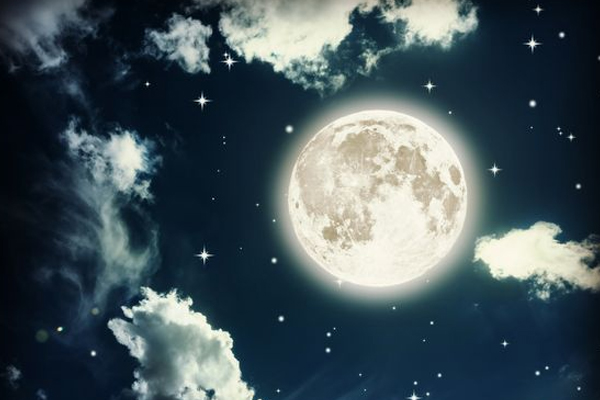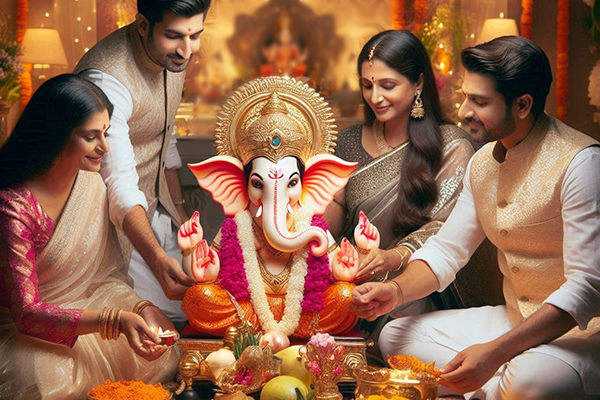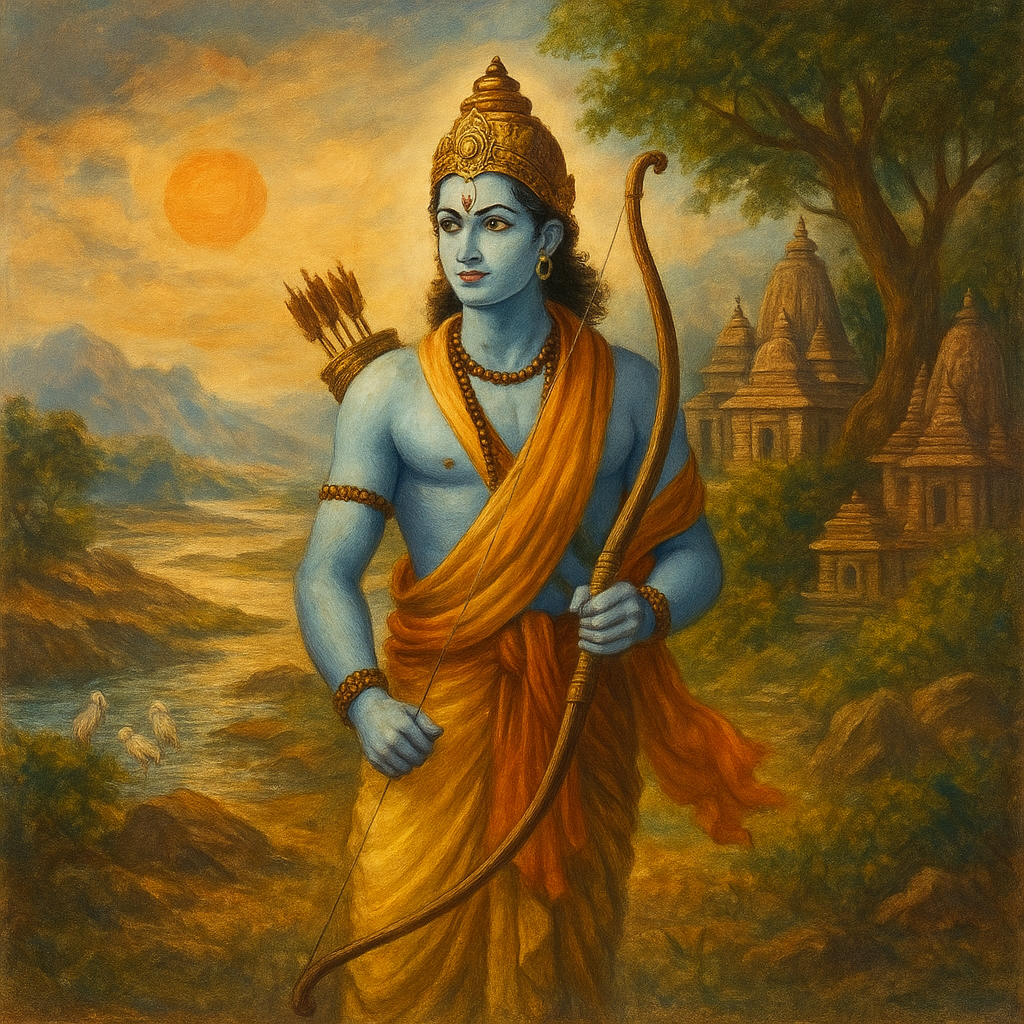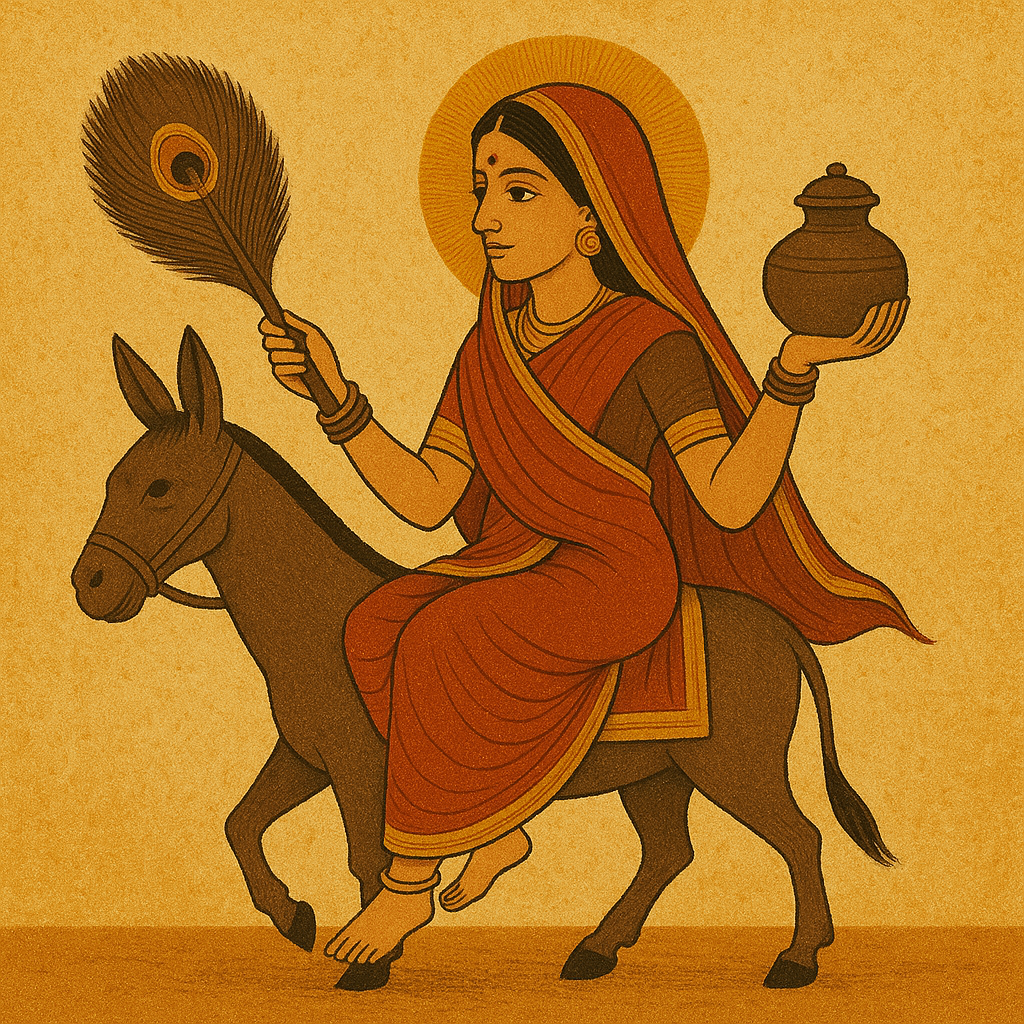
The practice of following Moon cycles, be it Purnima (full Moon) or Amavasya (No Moon), exists since ancient times in India.
Purnima days are considered high vibration days when people perform ritualistic worship of deities and other religious/spiritual activities. The Bhadrapada Purnima is an auspicious day and is the full Moon Day of Bhadra or Bhadrapada month (August-September) as per Hindu calendar. It also marks the end of the Bhadrapada month.
When is Bhadrapada Purnima Celebrated? Tithi & Muhurat (Date & Time)
Bhadrapada Purnima Upavasa on Friday, September 25, 2026
Moonrise on Purnima Upavasa Day - 06:34 PM
Udaya Vyapini Bhadrapada Purnima on Saturday, September 26, 2026
Purnima Tithi Begins - 01:36 PM on Sep 25, 2026
Purnima Tithi Ends - 12:48 PM on Sep 26, 2026
Bhadrapada Nakshatra:

According to the Indian Astrology, the zodiac comprises of 360 degrees. There are 27 Nakshatras or Constellations which are mentioned in the Indian Astrology. The value for each Nakshatra is denoted as 13 degrees and 20 minutes when measured from a fixed point. Every Nakshatra is divided into Charan or Pada, every Nakshatra has 4 Charan or Padas. The 27 Constellations form a 360 degrees Zodiac circle. There are two types of Bhadrapada Nakshtra, also called twins, Purva Bhadrapada and Uttara Bhadrapada. Purva Bhadrapada is the twenty-fifth of the 27 Nakshatra (constellations) in Hindu astrology. It is placed under the domain of Brihaspati, the deity represented by the planet Jupiter. Whereas Uttara Bhadrapada is the 26th Nakshatra in Hindu astrology. It is ruled by Shani, the deity identified with the planet Saturn .
What is Bhado/Bhadrapada Month?

Bhadrapada is the 6th month of the Hindu calendar, which generally coincides with August and September of the Gregorian calendar. According to Hindu mythology and astrology, Bhadrapada is a special month for sacred fasting and devotion. Popular as Bhadrapada or Bhado, many unique religious festivals like Janmashtami and Ganesh Chaturthi are celebrated this month.

Conducting the Satyanarayan Puja Vrat and listening to or reading the Vrat Katha on this holy day is beneficial for the devotees as it brings all round happiness by eliminating pains and miseries.
On this day, Bhadrapada Purnima Vrat, Satyanarayan Puja and Katha, are done in most of the Indian households. As per the Narad Purana, when Narad Muni asked Bhagwan Vishnu about how the miseries of the world can be overcome. Vishnu guided by saying that those who perform the Satyanarayan Puja Vrat and hear or read the Satyanarayan Katha, will be able to gain freedom from unhappiness and enjoy a prosperous, happy life. Satyanarayan Puja and Vrat done on Bhadrapada Purnima holds special significance, compared to the other days when Satyanarayan Puja can be conducted and brings benevolent blessings of Satyanarayan.
How to Celebrate Bhadrapada Month?

Bhadrapada Purnima is celebrated in all states across India. In the state of Gujarat Goddess Ambaji is worshipped with fanfare and devotees observe the Bhadrapada Purnima Vrat. In certain places of the Southern states of India, Mother, Goddess Shakti is honored and worshipped on this day. The next day after Bhadrapada Purnima begins the Pitra Paksha or Shraddha.
On Bhadrapada Purnima, as mentioned in the Narad Purana, Uma- Mahesh Vrat is also observed, which is said to have been observed by Bhagwan Vishnu too. Uma- Mahesh Vrat, is the worship of the supreme God Shiva and Goddess Parvati by observing a fast and is especially meritorious for women. Uma Mahesh Vrat, observed on Bhadrapada Purnima, blesses with healthy, intelligent children, prosperity and good fortune.
The Bhadrapada Purnima is a very appropriate day to perform the Maha Mrityunjaya Havan to bring good health and keep negative influences at bay.
Bhadrapada Purnima Vrat & Puja Vidhi:

Bhadrapada Purnima is one of the best days to worship Shri Satyanarayan by meticulously following the Bhadrapada Purnima Vrat Puja Vidhi, which also includes the narration of Satyanarayan Vrat Katha which is heard respectfully by every devotee. The Satyanarayan Katha has many interesting stories about the merits of observing this fast and the glorious blessings of Bhagwan Vishnu. This Puja and Vrat are so beneficial that whoever gathers to be present on this occasion.
Conducting the Bhadrapada Purnima Puja and vrat is easy enough to be conducted at home by you with the help of other family members. However, you may also choose to get this Puja Vidhi conducted by a qualified and experienced Pandit. It is of utmost importance that the Satyanarayana Puja is attended by as many people as possible, be it friends, family, neighbors and devotees should leave only after hearing the Satyanarayan Vrat Katha and having Prasad/Prasadam.
It is also believed those invited to the Puja should not refuse to attend. The Bhadrapada Purnima Puja can be attended by men and women of any religion, caste, from any country, without any discrimination.
Since Bhadrapada Purnima Vrat Puja Vidhi should be followed, it is recommended to ensure that all the ingredients/items required for the Puja are available at hand, like:
Tulsi leaves
Betel leaves & Betel nuts
Fruit for offering to Divine etc.
The devotee performing the Bhadrapada Purnima Vrat Puja Vidhi should ideally have a bath in the Ganga, Narmada River early in the morning, as it is considered most pious to bathe in the waters of these holy rivers. However, you can also mix Gangajal with your bath water.
Take the Sankalpa or intention of keeping the fast.
Devotees attending the Bhadrapada Purnima Vrat Puja should be in fresh clean clothes.
The room where the Puja is to be performed should be neat and clean.
A raised platform or Puja Chowki is covered with Yellow Cloth to set it as the Alter for the puja, decorated with flowers.
The unique and sacred Shaligram stone, known as a representation of Bhagwan Vishnu/Narayan, is installed in the Alter for the Puja.
The Puja Kalash is ritualistically established in front of the Altar. The room should be well lit.
Lighting Ghee Lamps and Incense are part of the Bhadrapada Purnima Vrat Puja Vidhi.
A very important part of the Bhadrapada Purnima Vrat Puja Vidhi is performing Abhishekham (sacred bath) of the Shaligram stone with the Panchamrit mixture of Cow Milk, Ghee, Curd, Honey, Sugar.
The Panchamrit which remains in the vessel post Abhishek, is later distributed to devotees who are attending the puja, before having the Prasad.
Sandalwood paste and Tulsi leaf is offered to Shaligram and other rituals are conducted.
Tulsi leaves are favorite of Bhagwan Vishnu and offered during the Satyanarayan Puja with every Mantra that is chanted.
Special sweet Prasad is offered to Shri Satyanrayan, which has different variations in different parts of India.
Generally, a mixture of roasted Wheat flour, Banana, Sugar, dry fruits and other fruits is offered.
In Maharashtra and Gujarat Sheera (made of Suji/Semolina), in Punjab Wheat Panjiri, in West Bengal the Prasad for Satyanarayan Puja is called Shinni and prepared by mixing Banaban, Flour(Maida) Sugar or Gur(Jaggery), full cream Milk, Grated Coconut, Khoya(condensed Mil), Kishmish(Raisins), Cashew Nuts, are offered with love and respect to Shri Satyanarayan.
The special Prasad offering is part of Bhadrapada Purnima Vrat Puja Vidhi. It is a must to consume this Prasad by everyone who has participated in the puja and not waste even a drop of it.
The Bhadrapada Purnima Vrat Puja Vidhi takes almost 3 hours to perform with care.
The Satyanarayan Katha is an integral part of this Puja, and the Puja and Vrat remains incomplete if the Vrat Katha is not heard.

The Satyanaryan Vrat Katha is a collection of stories that highlight Bhagwan Vishnu's love for his devotees, the benefits one enjoys if the meritorious Satyanarayan Vrat is observed.
Devotees should listen without disturbance/distraction of any kind, with focus.
The Bhadrapada Purnima Vrat & Puja ends with Aarti of Shri Satyanarayan.
Devotees also can choose to spend time singing Bhajans (devotional hymns), Kirtans to show their love for the divine.
Bhadrapada Purnima Vrat Vidhi & Vrat Katha (Fasting Rituals):
According to religious beliefs, observing the Uma-Maheshwar fast brings wealth and prosperity. This observance of fast helps in maintaining balance and peace in life. By observing this fast, physical and mental strength increases. This fast also brings sweetness to love relationships.
The fast is then broken to end the Bhadrapada Purnima Vrat Puja Vidhi.
Salt, Pulses and Grains are strictly prohibited in the Satyanarayan fast.
Fruit can be consumed if the devotee is not keeping a complete fast due to health reasons.
Shri Satyanarayana Katha:

Shri Satyanarayana katha (narrative) comes from the Skanda Purana, Reva Kanda. Suta Maharshi narrated these stories, in Naimisharanya to the Rishis who were performing a 1,000-year yagna for the benefit of mankind lead by Shounak ji.
In the stories characters who ignored their promise to perform the puja after their wish had been fulfilled, suffered as a result. Therefore, one is to deduce that one must stick to the promise given to the Bhagwan in exchange for the desire fulfilled by his grace.
One is not to ignore or forget the divine’s Grace. Prasad is symbolic of God's Grace which Kalavati (an important character from Satyanarayan Katha) ignored as she learned of her husband’s safe return. One can understand her eagerness in wanting to be re-united with her beloved, but one must understand that if one forgets to be thankful for gifts received from Bhagwan, one will have to go through another test until one remembers to remember. When the rich merchant is asked what the boat contains, he untruthfully replies ‘Only dry leaves and the Mendicant says, ‘So be it’.
The above incident tells us that the spoken word has power. What you speak manifests. Hence one must not speak an untruth. Especially an inauspicious untruth. In other stories one learns that no one is higher or lower in status in the eyes of Shri. Hence one must accord respect to whoever it may be, who is taking the name of God. Katha details:
Story 1:
Suta Maharshi narrated the stories. Once upon a time while travelling the three worlds, Narada Maharshi reached Bhoolokam (Earth) and saw the human beings immense suffering. He then went to the abode of Sri Satyanarayana Swami (the benevolent form of Vishnu), who alone can relieve mankind from the sufferings.

There he met Bhagwan Vishnu with four arms each with Shankha, Chakra, Gadha & Padma, wearing Tulsi Mala (garland) in his neck. Narada Maharshi then asked the lord for a panacea for the miseries of the world. Sri Satyanarayana told Narada Maharshi that there is a fast and puja which can be performed by anyone to overcome these obstacles. Bhagwan said, “Anyone who performs Shri Satyanarayan Swami’s Vratham & Puja in the right way they will get all the pleasures on Earth & will reach their goal”. The fast would result in the fulfillment of his desires and liberation from the cycle of birth and death into attaining moksha (salvation). Whosoever performs Shri Satyanarayana Swami’s Katha with a Brahmin and with his family with full rites/rituals, they will be relieved off their sufferings and sorrows. They will be bestowed with wealth & wisdom; they will be blessed with children, and they will get overall victory & increased devotion. For this prayer, one requires ripe bananas, ghee, milk & choori (made with wheat flour, ghee & sugar). After the prayers, all presents must have the prasadam & then take their meals together, & then sing, praise, & chant mantras of Shri Satyanarayana Swami. By doing this, their wishes will be fulfilled. This vratham in kaliyugam gives boon (reward) very quickly. This chapter of Satyanarayana Swami is over. All chant together (say) Shri Satyanarayana ki jai.
Story 2:

Shri Satyanarayana then narrated to Narada Maharshi how and who performed the puja first. In a place named Sunder Kashipur, there used to live a very innocent Brahmin. In hunger & thirst he used to roam begging for his daily bread. When Shri saw the Brahmin in sorrow and begging daily, he disguised himself as an old Brahmin & asked him, “Oh Brahmana, why are you so sad. Please tell me all about your difficulties. Is there any way I could help you?”. The Brahmin replied, “I am a poor Brahmin & I roam daily for bread. Do you know if there is any way to come out of all this sorrow?”. Then Shri in disguise of a Brahmin said “Shri Satyanarayana grants all the wishes of all the people if his puja and fast is performed diligently. If you pray to him & keep his fast you will overcome all your sorrow and get moksha”. After telling him all the details of the prayer and the fast, Bhagwan disappeared. The poor Brahmin could not sleep that night. He kept thinking of the fast and the prayer which the Lord had asked him to do. In the morning, he woke up with the thought that somehow, he must perform the puja and so thinking went out for his bhiksha (alms). On that day the Brahmin got a lot of money. He used to buy all the necessary things for the prayer. He called his family and performed Lord Satyanarayana’s prayer. By doing so, the Brahmin overcame all his sorrows & became rich. From then onwards, he performed the prayers every month without fail. Thus, whoever performs Lord Satyanarayana Swami’s puja, they will be relieved from all sorrows.
Daan or Donation on Purnima:

Donating food on Purnima is very auspicious. Click on the below link to donate:
Clothes to Brahmins and the needy on Bhadrapada Purnima is highly beneficial. Click on the below link to donate clothes:
Book Clothes Donation (Vastra Daan)
Individuals who have bought a new house choose Bhadrapada Purnima for Griha Pravesh Puja ceremony as this is one of the most auspicious and suitable days of the year for this ceremony.


-in-Astrology.jpg)






.jpg)




Comments 0
Leave your thought here